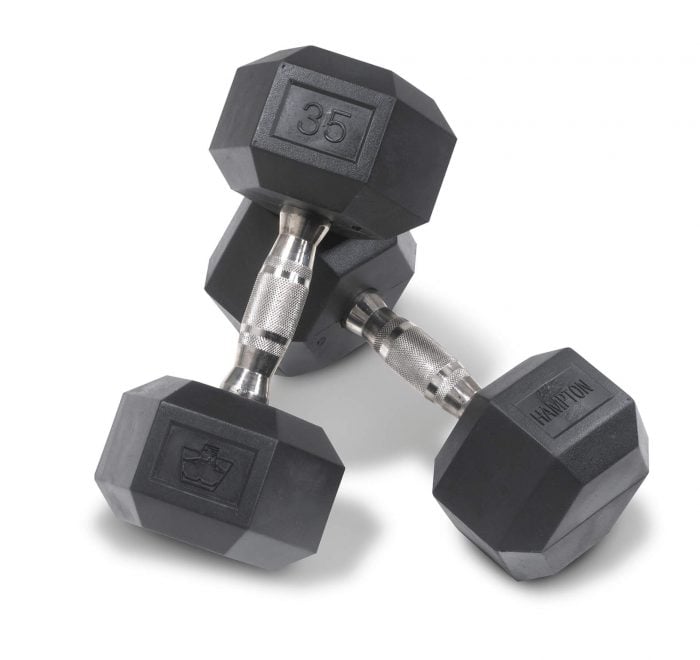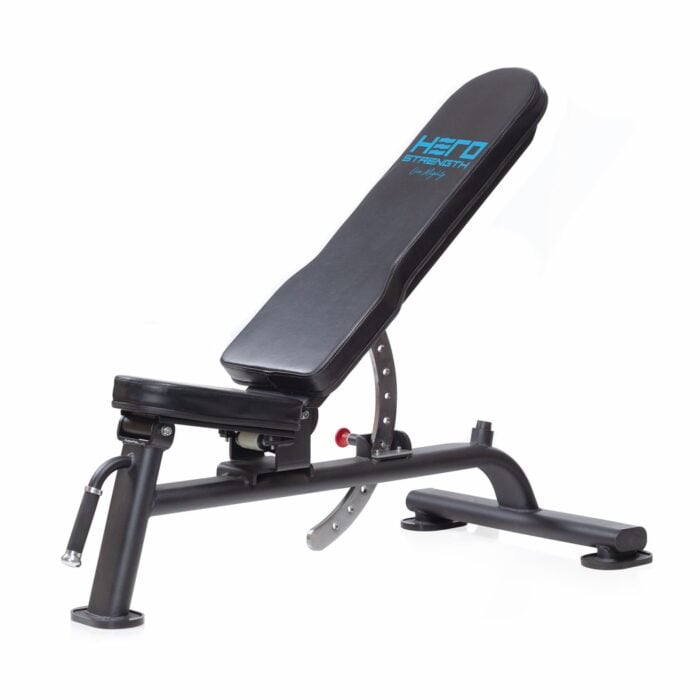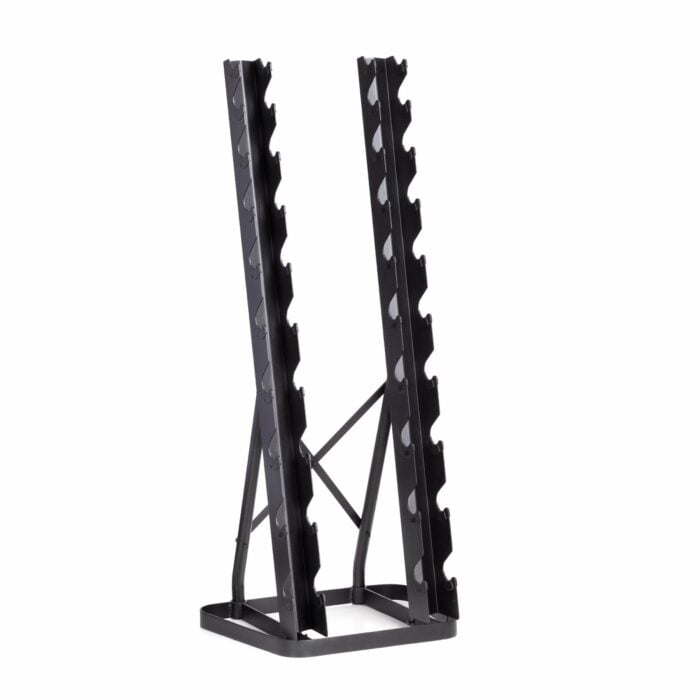Dumbbells are a great fitness tool for strengthening your quads! They can be used to maximize a wide variety of leg exercises that focus on building up your quad strength! This versatility will allow you to build your dream legs without getting bored in the process! Let’s discuss why it’s essential to train your quads and go over exercise options for doing so.
Key Takeaways:
- Training your quadriceps is vital because strong quads improve leg strength, joint stability, balance, and fat loss.
- When you take the time to train your quads, everyday activities such as taking the stairs and carrying heavy items will become easier!
- It’s always important to monitor your form and assess your weight choices as you do quadriceps exercises with dumbbells.
Quadriceps
Before you start training your quads, it’s essential to understand the anatomy of these big and strong leg muscles! This muscle group is located on the front of your thighs and consists of four muscles.
- Rectus Femoris: The rectus femoris is in the front and center of the middle of the thigh. Its primary function is to help extend the knee and help with hip flexion.
- Vastus Lateralis: The vastus lateralis muscle is the largest and strongest muscle of the group. It helps to straighten the knee and is the key player when it comes to getting up out of a chair and going up and down stairs.
- Vastus Intermedius: The vastus intermedius is the deepest muscle in the quadriceps group. It helps facilitate knee extension.
- Vastus Medialis: The vastus medialis is positioned at the inner side of the thigh. It extends the knee joint and also helps your patella track correctly.
All the muscles that make up your quadriceps are team players for your knees! They work together to extend the knee joint. The patella, which is also in the quadriceps tendon, increases the leverage of quad muscles helping exert force when the knee extends. The femoral nerve innervates all four quad muscles together. Due to the complexity of the quads, this muscle group requires proper training and careful exercise selection to ensure each muscle is targeted and trained well.
Recommended products
-
Hampton Dura-Bell® Urethane Dumbbells – Pairs
$31.00 – $914.00 -
Hampton Adjustable Bench | J-Bench
$599.00 -
Vertical Twin Tower Dumbbell Rack | 10 Pairs
$599.00
Quadriceps Workouts
Everyone wants great-looking legs, but there are many benefits to having strong quads besides aesthetics! It’s important to note that strong quads have the potential to benefit your health and fitness as a whole. Your quads are vital to lower body function and movement.
When you dedicate time to your quads, you say yes to improved leg strength, stability, and balance! These things are essential to your overall health and can improve athletic performance. Training your quads properly will help with overall body composition by increasing muscle mass and metabolism! This is helpful when it comes to weight loss and management. Strengthening the quads can help prevent those common dreaded knee injuries, such as ACL tears. When your knee is stabilized (by a strong quad), you have a lesser chance of injury.
It’s pretty clear focusing on the quads during your workout has many physical and functional benefits.
While aesthetic appeal isn’t the top reason for training your quads, it also comes with perks! Well-defined, strong quads can improve the appearance of your legs, leading to improved confidence and self-esteem. Ultimately, what’s most important is that healthy quads will significantly contribute to everyday life and make common tasks less taxing to the rest of your body.
Benefits of Dumbbell Exercises
There are many benefits to using dumbbells while you work to grow and strengthen your quads. You’ll notice increased strength as you move beyond bodyweight exercises into progressive strength exercises. As you get stronger, you’ll begin to see improved muscle tone. Using dumbbells during lower body workouts will help develop lean muscle mass in your legs, improving muscle tone and definition. Additionally, better bone density is a perk of doing weighted quad exercises! Increased bone density can help reduce your risk of osteoporosis later in life.
Using weights during your quad workout will give you a better calorie burn for your time (who doesn’t want that?). You may find yourself burning more calories on leg day than on the days you’re focusing on other muscle groups. Added burn can help control your weight and aid in weight loss.
Finally, weighted quad exercises will help improve your functional movements. Strong legs are a must for everyday activities. We often take our legs for granted, but as you strengthen them, you’ll notice that daily activities like walking, stair climbing, and carrying heavy objects will become easier! If your legs are strong, you’ll be less inclined to lift with your back, thus reducing the chance of back injuries.
Dumbbell Quad Exercises
We’ve put together some dumbbell quad exercises you can try at home. This line-up consists of six exercises that can be performed using dumbbells to build your quads. The exercises target different areas of the quads while improving lower body strength, balance, and stability. When executed correctly and with proper form, this routine can help you build stronger and more defined quad muscles, improve athletic performance, and reduce the risk of injury.
Try these quad exercises!
Goblet Squat
The goblet squat is a squat exercise where you hold a weight close to your chest, usually in a goblet grip with both hands. This exercise provides a full-body workout as squats engage multiple muscle groups simultaneously. It will help improve lower body strength, enhance mobility and flexibility, and activate your core. Goblet squats are also great for beginners and those who need a versatile and accessible exercise!
Here’s how to do a goblet squat:
- Hold a dumbbell vertically against your chest, with your elbows pointing down.
- Stand with your feet shoulder-width apart and your toes slightly turned out.
- Lower your body into a squat by bending at the knees and hips, keeping your back straight and chest up.
- Push through your heels to stand back up to the starting position.
Dumbbell Bulgarian Split Squat
The Bulgarian split squat is a unilateral lower-body exercise that targets the quads, hamstrings, glutes, and stabilizer muscles. By placing one leg behind you on an elevated surface, such as a bench, and performing a squatting motion with the other leg, you increase the effort of the working leg. The Bulgarian Split Squat helps improve leg strength imbalances, enhances stability, and challenges core engagement. It also offers a greater range of motion than traditional squats and can improve hip flexibility.
Here’s how to do a Bulgarian split squat:
- Stand facing away from a bench or step with a dumbbell in each hand.
- Place the top of your left foot on the bench or step behind you.
- Lower your body into a lunge by bending your right knee and hip, keeping your torso upright.
- Push through your right heel to stand back up to the starting position.
- Repeat on the other side.
Dumbbell Front Squat
The dumbbell front squat is a variation of the squat exercise where you hold dumbbells at shoulder level, with palms facing each other, and perform a squatting motion. This exercise places a greater emphasis on the quadricep area and core compared to back squats. Holding the weight in front of your body challenges your core stability and promotes an upright posture. Dumbbell front squats can help develop leg strength, enhance overall lower body power, and improve core stability. The Dumbbell front squat is a great go-to exercise to keep in your rotation.
Here’s how to do a Dumbbell Front Squat:
- Hold a pair of dumbbells at shoulder height, with your palms facing each other and your elbows pointing forward.
- Stand with your feet shoulder-width apart and your toes slightly turned out.
- Lower your body into a squat by bending at the knees and hips, keeping your back straight and chest up.
- Push through your heels to stand back up to the starting position.
Step-Ups With Dumbbells
Step-ups with dumbbells involve stepping onto a platform or bench while holding dumbbells in each hand. This exercise primarily targets the quadriceps, glutes, and hamstrings. You will improve unilateral leg strength and balance by stepping up and down with one leg at a time.
Step-ups also engage the hip and knee stabilizer muscles, promoting joint stability. The step-up exercise can be adjusted in height to suit different fitness levels and provides a functional movement that mimics climbing stairs or hiking.
Here’s how to do Step-ups with Dumbbells:
- Stand facing a bench or step with a dumbbell in each hand.
- Step up onto the bench or step with your right foot, keeping your chest up and your shoulders back.
- Step down with your left foot and repeat the process for the desired number of reps.
- Switch legs and repeat.
Dumbbell Forward Lunge
Dumbbell forward lunges are an effective lower-body exercise that targets the quadriceps, hamstrings, glutes, and calves. You engage multiple muscles by stepping forward and lowering your body into a lunge position. This exercise improves leg strength, stability, and balance.
Dumbbells add resistance, increasing the challenge and stimulating muscle growth. Forward lunges also promote hip flexibility and help develop coordination and control. Make sure to engage your core and always watch your spinal alignment.
Here’s how to do a Dumbbell Forward Lunge:
- Hold a dumbbell in each hand with your arms at your sides.
- Take a big step forward with your right foot and lower your body into a lunge by bending both knees.
- Keep your back straight and your chest up as you lunge.
- Push through your right heel to stand back up to the starting position.
- Repeat on the other side.
Dumbbell Lunges
Dumbbell lunges are similar to forward lunges, but instead of stepping forward, you step back. This variation primarily targets the glutes, hamstrings, and calves while engaging the quadriceps and core. Dumbbell lunges enhance lower body strength, improve balance, and stimulate muscle growth. Stepping backward challenges stability and requires greater control, making it a slightly different movement pattern than forward lunges.
This fun and challenging exercise helps develop overall lower body strength and stability. For an even better burn, increase your weight and reps as you gain strength!
Here’s how to do a Dumbbell Lunge:
- Hold a dumbbell in each hand with your arms at your sides.
- Take a big step forward with your right foot and lower your body into a lunge by bending both knees.
- Keep your back straight and your chest up as you lunge.
- Push through your right heel to stand back up to the starting position.
- Repeat on the other side.
Ready to Get Your Quad on With Hampton Fitness?
If you’re ready to build better quads or simply up your current quad training routine, check out the selection of fitness equipment available by Hampton Fitness. We offer a wide range of dumbbells for athletes of all fitness levels to help you get the most out of your workouts. Whether you’re a fitness enthusiast or a professional athlete, our products are designed to help you reach your fitness goals and achieve optimal results. Take the next step in your fitness journey and explore our dumbbell product lines today.





